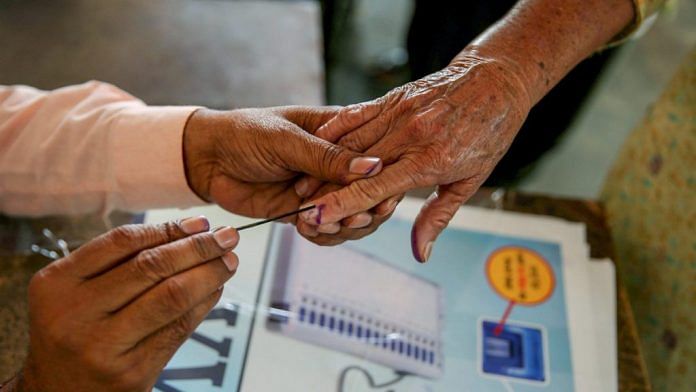New Delhi: Assembly polls in five states — Uttar Pradesh, Punjab, Uttarakhand, Manipur and Goa — will be held between 10 February and 7 March this year, chief election commissioner Sushil Chandra announced Saturday. The counting of votes will take place on 10 March.
Uttar Pradesh elections will be held in seven phases on 10, 14, 20, 23 and 27 February and on 3 and 7 March. While Punjab, Uttarakhand and Goa will vote on 14 February, Manipur elections will be held in two phases on 27 February and 3 March.
The elections in UP are especially crucial for BJP’s prospects in the 2024 Parliamentary elections, as the state with 80 Lok Sabha seats will set the momentum for the bigger battle two years later.
Of the five states, four have Bharatiya Janata Party (BJP) governments. Punjab, under Congress rule, is currently the only non-BJP led state among these.
The stakes are high for both national and regional parties and Prime Minister Narendra Modi and the BJP’s top brass have already been investing in campaigns in these states for the past few weeks.
The polls coincide with a steep surge in Covid-19 cases across the country, for which the ECI announced a set of protocols, including an advice for virtual campaigns rather than physical gatherings. Chandra also said that violation of Covid-19 protocols may attract penal provisions under the Disaster Management Act and even a possible ban on further campaigning. The ECI has also imposed restrictions on victory marches by parties and a maximum cap of five individuals for door-to-door campaigning.
High-stake elections
While the BJP is investing heavily in UP, it is facing a number of challenges here.
For one. it is facing anti-incumbency and its support base in Western UP is also said to have taken a hit due to the now-repealed controversial farm laws.
The Samajwadi Party (SP), which was in power in the state between 2012 and 2017, is putting up a strong show with party chief Akhilesh Yadav’s rallies drawing impressive gatherings. He has also aligned with a host of smaller political outfits representing different caste groups rearranging caste-based vote bases, to fight the BJP in UP.
The BJP on the other hand is banking heavily on PM Modi’s popularity, as also that of CM Adityanth. The party is showcasing the Adityanath government’s development works, as also his efforts towards making UP crime free. The party is also aggressively following its Hindutva agenda which is being seen as an attempt to polarise voters on communal lines.
Punjab is likely to witness a multi-cornered contest with the ruling Congress pitted against a resurgent AAP and an alliance between the BJP and former CM Amarinder Singh’s newly-floated party.
The Shiromani Akali Dal (SAD) which had broken its alliance with the BJP over the issue of farm laws is struggling to make a mark in this election as farmers are upset with the party for having been a part of the union cabinet decision on the farm laws.
Of political highs and lows
Uttarakhand on the other hand is facing a major anti-incumbency. The ruling BJP was forced to change its chief minister twice. Current CM Pushkar Singh Dhammi is the third since 2017, when the BJP came to power in the state. The state continues to face major challenges on the development front, such as lack of jobs, hospitals, and good schools, according to senior leaders across parties.
The hill-state also witnessed differences within the Congress, which remains the main opposition. Last month former chief minister and party general secretary Harish Rawat hit out at All India Congress Committee (AICC) general secretary and Uttarakhand in-charge Devendra Yadav and the party’s central leadership, alleging that he was not being allowed to work freely towards preparing for the 2022 assembly elections. Rawat later met the Gandhis in Delhi and claimed that the problems have been resolved.
In Manipur, the ruling BJP has witnessed its own highs and lows.
In 2017, the BJP toppled a 15-year-old strong rule of the Congress here, to strengthen its hold over the north-east region, where it had already won the Assam polls in 2016. It was a closely-contested election with MLAs in both Congress and BJP winning with narrow margins in most seats.
Despite the Congress winning a higher number of seats, the BJP managed to form a government through alliances with the Naga People’s Front in the Naga hill areas of the state and Conrad Sangma’s National People’s Party (NPP). One Congress MLA also defected to the BJP. Over the following years, several MLAs from the BJP defected to the Congress. It has also witnessed rough patches in its alliance with the NPP.
There is a widening gap between the Hills (inhabited by the tribal communities) and the Valley (where Hindu-Meiteis are the dominant community) in Manipur, and Singh has been struggling to bridge this. With a number of smaller parties playing a major role in the state’s political canvas, Manipur continues to be a tough and unpredictable fight.
Meanwhile, the ruling BJP in Goa is not only facing anti-incumbency, but also dissension from within with many MLAs and leaders joining other parties. While the Congress is the principal challenger here, the Trinamool Congress’ entry in the fray and AAP’s renewed thrust promises to make this election an interesting contest.
Also read: Hindu-vs-Hindutva, Priyanka ‘experiment’ — the strategy Congress is prepping for 2022 & beyond






